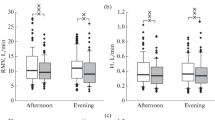Summary
Dopamine in urine was investigated during three levels of physical stress (at 35%, 50%, and 75%\(\dot V_{{\text{O}}_{\text{2}} {\text{max}}}\)) and three kinds of mental stress (delayed auditory feedback, vigilance task and arithmetic task). A statistically significant increase in excretion of dopamine was found in response to physical exercise and the delayed auditory feedback test. The response patterns (ratios noradrenaline/dopamine and adrenaline/doparnine) after physical and mental stress differed. The data presented support the possibility of using dopamine excretion and the above ratios to differentiate between mental and physical effort.
Similar content being viewed by others
References
Faucheux B, Kuchel O, Cuche JL, Messerli FH, Buie NT, Barbeau A, Genest J (1976) Circadian variations of the urinary excretion of catecholamines and electrolytes. Endocrinol Res Commun 5:257–272
Fibiger W, Singer G, Miller AJ, Armstrong S, Datar M (1984a) Changes in cortisol and urine catecholamines as a function of time of day, life events and self-report of mood changes. Neurosci Biobehav Rev [in press]
Fibiger W, Singer G, Miller AJ (1983b) Relationships between catecholamines in urine and physical and mental effort. Int J Psychophysiol [in press]
Frankenhaeuser M (1979) Framework for psychoneuroendocrine studies. In: Howe HE, Dienstbier RA (eds) Nebraska Symposium on Motivation 1978. University of Nebraska Press, Lincoln, pp 123–161
Hoeldtke R, Baliga BS, Issenberg P, Wuntma RJ (1972) Dihydroxyphenylalanine in rat food containing wheat and oats. Science 175: 761–762
Kuchel O, Bun NT, Unger T (1979) Free and conjugated dopamine. Physiological and clinical implications. In: Imbs JL, Schwartz J (eds) Peripheral dopaminergic mechanisms. Pergamon Press, New York, pp 15–27
Lehmann M, Huber G, Splori M, Keal J (1982) Catecholamine excretion during physical exercise and mental performance. Int Arch Occup Environ Health 2: 175–186
Moyer TP, Jiang N, Tyce GM, Sheps SG (1979) Analysis for urinary catecholamines by liquid chromatography with amperometric detection: methodology and clinical interpretation of results. Clin Chem 2: 256–263
Sanchez J, Pequignot JM, Peyrin L, Monod H (1980) Sex differences in the sympatho-adrenal response to isomatric exercise. Eur J Appl Physiol 45: 147–154
Van Loon GR, Schwartz L, Sole MJ (1979) Plasma dopamine responses to standing and exercise in man. Life Sci 24: 2273–2278
Van Loon GR, Sole MJ (1980) Plasma dopamine: source, regulation, significance. Metabolism [Suppl 33] 1: 1119–1123
Von Euler SU (1974) Sympatho-adrenal activity in physical exercise. Med Sci Sports 6: 165–173
Author information
Authors and Affiliations
Rights and permissions
About this article
Cite this article
Fibiger, W., Singer, G. Urinary dopamine in physical and mental effort. Europ. J. Appl. Physiol. 52, 437–440 (1984). https://doi.org/10.1007/BF00943376
Accepted:
Issue Date:
DOI: https://doi.org/10.1007/BF00943376




